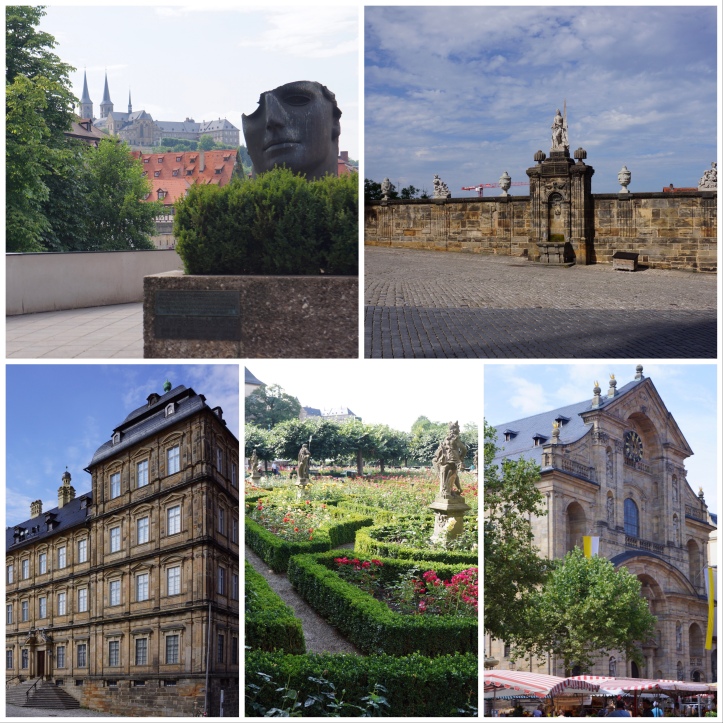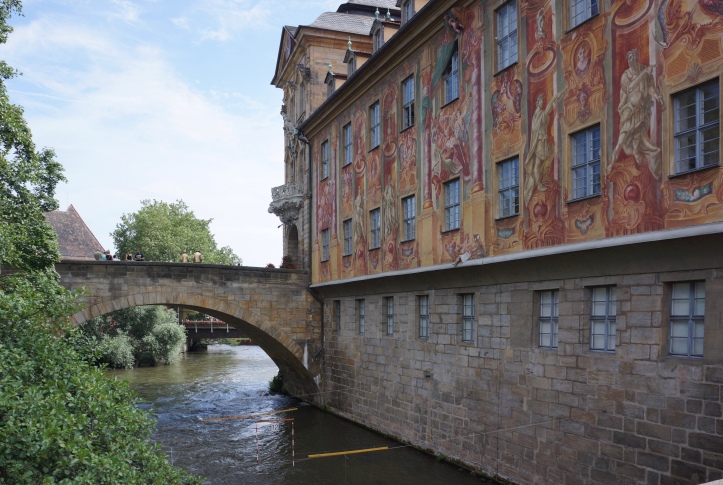NOTE: These travel pictures are from travels prior to us becoming nomadic in 2018. Like most of the world, we are staying put right now until the threat from COVID19 is either over or preventable via a vaccine.
Getting lost in history is wonderful. Getting lost and separated from your tour group less so.

The Gabelmann (“Fork Man”) Fountain in Bamberg is a Baroque image of the Roman God Neptune with his three-pronged fork, erected in 1566. The square surrounding it is a favourite meeting point in the town. Our local contact assured us that we would be perfectly safe exploring the town on our own, since (1) we’d be able to see the statue from every vantage point in town, and (2) absolutely everyone in town would be able to direct us to it if we used its name in the local Frankish dialect: “Gobl-Mo”. All we had to do was return to the fountain by 3:00 in order to board our river boat, which we knew would depart promptly with or without us. Easy peasy.
Except.
(1) The narrow streets, steep inclines, and tall buildings mean that, unless you are outside one of the 7 seven churches atop of one of the town’s seven hills, the statue is almost never visible from any of the side streets, and (2) apparently no one speaks the Frankish dialect any more, so polite requests (in German) for directions to the Gobl-Mo are met with blank stares, shrugs, and queries as to what on earth I was talking about.
I finally realized that simply asking for Neptune’s fountain got us the directions we needed. Our guide would not be getting a big tip, although I imagine they may have enjoyed a good laugh at our expense after we returned breathless at 2:59 for our 3:00 rendezvous.
Nonetheless, prior to our panic to get back to our meeting place, we had a wonderful day in Bamberg, enjoying the stunning architecture, gardens and quaint homes along the waterfront. 
 (Below) The Bamberg Cathedral of St. Peter and St. George may not be among the biggest churches we toured, but its stone construction reflects that it is one of the oldest, first consecrated in 1012 AD, with the current building completed in the 13th century. It contains the only papal grave in Germany, that of Pope Clement II (1005 – 1047AD). The equestrian horseman’s identity is still being debated.
(Below) The Bamberg Cathedral of St. Peter and St. George may not be among the biggest churches we toured, but its stone construction reflects that it is one of the oldest, first consecrated in 1012 AD, with the current building completed in the 13th century. It contains the only papal grave in Germany, that of Pope Clement II (1005 – 1047AD). The equestrian horseman’s identity is still being debated.
The windows of the Schlenkerla brewpub, in operation since 1405 AD, where ONE of us enjoyed the town’s famous Rauchbier (smoked beer), which tastes a bit like beer that has had cooked bacon swirled around in it. 
The old palace (Alte Hofhaltung) complex (below) dates to the 11th century, and now houses a museum.
The Altes Rathaus (old city hall) has some of the most beautifully painted exterior facades we’ve seen to date. The building is built on an island in the centre of town, in the Regnitz River, and accessed by stone bridges. The original building dated to the 1400’s, but this Baroque and Rococo iteration was built between 1744 and 1756. The mural was refreshed between 1959 and 1962, giving it its current vibrancy.
What a lovely town….
Can’t respond to this one; must talk!
Interesting – as always!
>>
LikeLike